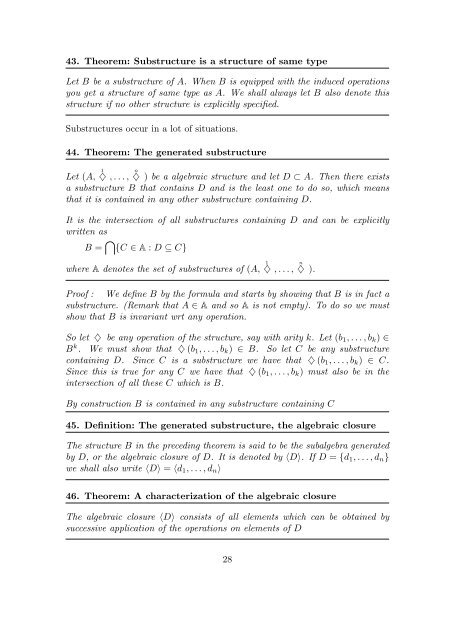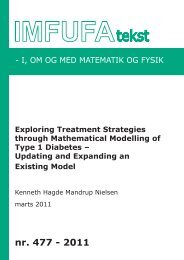ABSTRACT ALGEBRAIC STRUCTURES OPERATIONS AND ...
ABSTRACT ALGEBRAIC STRUCTURES OPERATIONS AND ...
ABSTRACT ALGEBRAIC STRUCTURES OPERATIONS AND ...
You also want an ePaper? Increase the reach of your titles
YUMPU automatically turns print PDFs into web optimized ePapers that Google loves.
43. Theorem: Substructure is a structure of same type<br />
Let B be a substructure of A. When B is equipped with the induced operations<br />
you get a structure of same type as A. We shall always let B also denote this<br />
structure if no other structure is explicitly specified.<br />
Substructures occur in a lot of situations.<br />
44. Theorem: The generated substructure<br />
Let (A, ♢ 1<br />
, . . . , ♢ n<br />
) be a algebraic structure and let D ⊂ A. Then there exists<br />
a substructure B that contains D and is the least one to do so, which means<br />
that it is contained in any other substructure containing D.<br />
It is the intersection of all substructures containing D and can be explicitly<br />
written as<br />
B = ∩ {C ∈ A : D ⊆ C}<br />
where A denotes the set of substructures of (A, ♢ 1<br />
, . . . , ♢ n<br />
Proof : We define B by the formula and starts by showing that B is in fact a<br />
substructure. (Remark that A ∈ A and so A is not empty). To do so we must<br />
show that B is invariant wrt any operation.<br />
So let ♢ be any operation of the structure, say with arity k. Let (b1, . . . , bk) ∈<br />
B k . We must show that ♢ (b1, . . . , bk) ∈ B. So let C be any substructure<br />
containing D. Since C is a substructure we have that ♢ (b1, . . . , bk) ∈ C.<br />
Since this is true for any C we have that ♢ (b1, . . . , bk) must also be in the<br />
intersection of all these C which is B.<br />
By construction B is contained in any substructure containing C<br />
45. Definition: The generated substructure, the algebraic closure<br />
The structure B in the preceding theorem is said to be the subalgebra generated<br />
by D, or the algebraic closure of D. It is denoted by ⟨D⟩. If D = {d1, . . . , dn}<br />
we shall also write ⟨D⟩ = ⟨d1, . . . , dn⟩<br />
46. Theorem: A characterization of the algebraic closure<br />
The algebraic closure ⟨D⟩ consists of all elements which can be obtained by<br />
successive application of the operations on elements of D<br />
28<br />
).
















